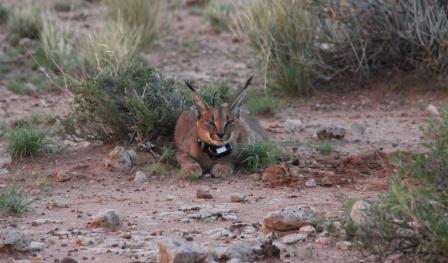Check out this video of a margay climbing down a pole. Captive, but very clear demonstration of their unique tree climbing skills. Check out that paw action as the cat clings in place, head down!
Spotted Bobcats In Texas
Researchers in the South Texas brush country are discovering that approximately one out of every ten bobcats has a striking resemblance to the endangered ocelot.
Killed Just Because He Lived
The Caracal Project in Namibia began in January 2011 and continues to expand. They are collecting ecological data on caracals at a large scale, and working with livestock farmers to mitigate conflicts with caracals and other predators. This is essential because caracals are the most persecuted cat in Africa, yet no country has a population estimate based on scientific data.
They are finding that more and more livestock farmers, those who have always killed caracals, are willing to allow the cats to be released back onto their farms as long as they are radio collared and the farmers are kept involved in our research. This is a vital aspect to changing farmer perceptions regarding caracals and other predators.
Update March 2012
I just wanted to send you an update that on The Caracal Project another caracal has been shot by a livestock farmer- a young male (above) whose range encompassed private and communal sheep farms. He lived on these farms for over 18 months without any documented predation on livestock. We are disappointed but appreciate being told by the farmer. Radio collars on three other caracals continue to collect data.
Hope all is better for you and I am sorry to share this bad news but it shows why this research is important. Thanks again for all your support and everything you do to save wild cats!
Aletris M. Neils
Executive Director
Conservation CATalyst
Great Overview of Field Research in Africa
This wonderful video from the Cape Leopard Trust gives an excellent overview of what field researchers must do to learn about cats in the wild. While they are looking for a big leopard, the same procedures are followed by scientists studying the small wild cats.
The Cape Leopard Trust in South Africa uses research as a tool for conservation, finding solutions to human-wildlife conflict and inspiring interest in the environment through an interactive and dynamic environmental education program. As well as leopards, they are studying a smaller cat through the Cedarburg Caracal Project.
Canada Lynx Population Peak
Canada Lynx have been receiving a lot of limelight the past couple of months.
A Colorado photo of two lynx on the roadside went viral, prompting calls to close the highway for the sake of the lynx. In Canada, a pair of lynx were photographed near Banff, AB and three were caught on video in British Columbia. A ski resort in Alberta is alternately closing its runs as reports of a female and her kitten are received.
For an animal that relies on its elusiveness, why are so many being reported this year? Meet the reason.
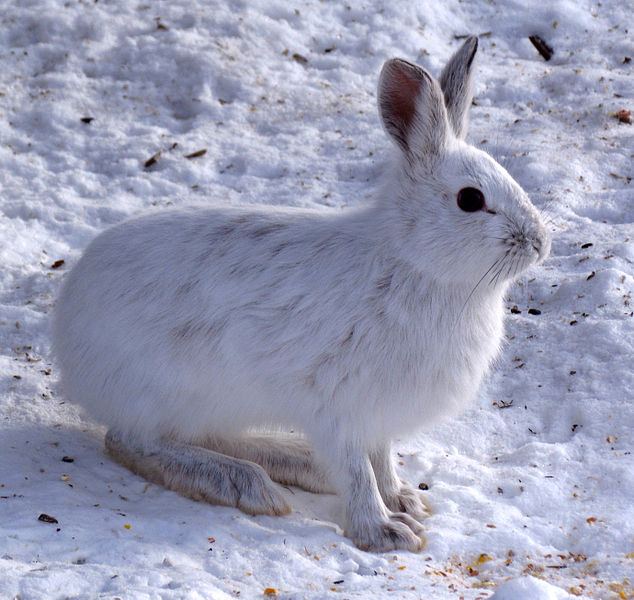
Snowshoe hares have a cyclical population which takes between eight and eleven years to go from peak, through decline, and back to peak. The period of abundance usually lasts for two to five years.
Sunspot activity, predator numbers, food availability, parasite load, stress and disease have all been investigated as causes of the cycle. All of these factors likely play a role, with predation and food availability being the most important. Litter sizes vary with the population cycle, with females producing more young during the low phase than during the peak.
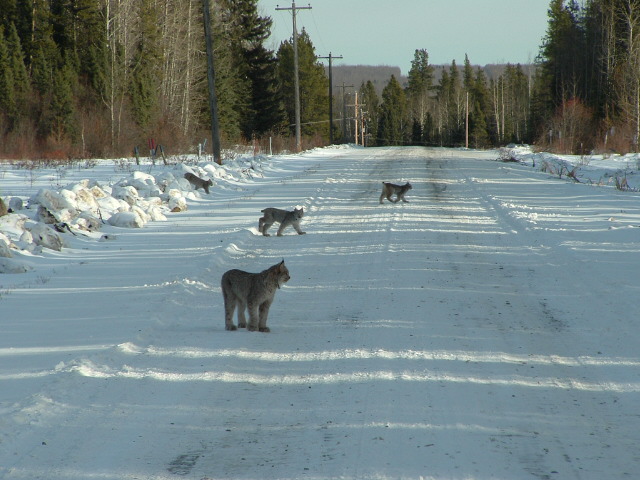
Canada Lynx feed almost exclusively on snowshoe hares, and their populations follow the hare cycle. A year or so after the hares have declined the Canada Lynx population crashes, helping ensure the survival rate of the few remaining hares. More will live to fuel the next population rebound, the lynx numbers will follow, and the cycle continues.
Scientists who have examined the fur-trading records of the Hudson’s Bay Company have been able to trace closely linked 10-year cycles of growth and decline in populations of the two species over the past 200 years.
Canada Lynx are currently at the peak of their cycle, and their numbers will slowly drop over the next few years.
Mating occurs during February or March each year, and the young (usually four) are born in April and May, 60 to 65 days later. Female kits may breed for the first time as they approach one year of age, but this depends on the abundance and availability of snowshoe hares and the physical and nutritional condition of the lynx.
Starvation following the rapid cyclic declines in snowshoe hare populations is the greatest single source of natural mortality among adult and yearling lynxes. About 40 percent of the total lynx population may starve to death following a crash in the snowshoe hare population. During the following three to four years, when the hare population is starting to rebuild, lynxes breed, but the kittens die before winter. This suggests that an adult female simply cannot support both herself and her litter when hares are scarce.
This lynx-snowshoe hare cycle is perhaps the greatest example of how intricately nature is balanced. If you live in Canada Lynx country and would like to increase your chances of seeing one, now would be the time to go looking.
The Number 1 Email Question
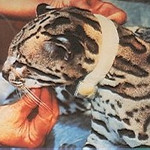 During the course of a year, we get a huge variety of questions via email. People send us cat pictures for identification, researchers are seeking funding, children ask about school projects and many inquire about our membership and programs.
During the course of a year, we get a huge variety of questions via email. People send us cat pictures for identification, researchers are seeking funding, children ask about school projects and many inquire about our membership and programs.
In 2012, the most common query was from people seeking a job on a biological field research project. We received mail and resumes from around the world, and unfortunately had to turn them all away.
ISEC Canada does not hire researchers for any project. We send financial support to projects that have been initiated by researchers who hire their own staff. Many of these projects are associated with universities, and the work is part of the course taken by students.
We heard from some truly amazing and enthusiastic people the past year. Wildlife biology is a noble field to get into and many wild species owe their very survival to these dedicated researchers. It is also an extremely difficult field to find work in, and we wish we could accommodate everyone who took the incentive to contact us. In reality, all we can do is wish them luck in their search, and thank them for their concern about wildlife.
Small Wild Cat Calendar
Wouldn’t you love a gorgeous small wild cat gracing your wall every month? We have only a few of these remaining in stock so now would be a great time to order! Calendar is 8 1/2″ x 11″ when closed. (*8 1/2″ x 22″ when hanging).
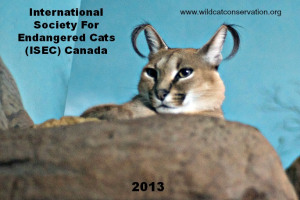 Thirteen gorgeous small wild cats are featured in this 2013 wall calendar, including photos taken in the wild and in zoos. There are some exceptionally rare photos in here this year! An ISEC Canada exclusive product.
Thirteen gorgeous small wild cats are featured in this 2013 wall calendar, including photos taken in the wild and in zoos. There are some exceptionally rare photos in here this year! An ISEC Canada exclusive product.
$19.95 Cdn includes all shipping costs. Proceeds to Black-footed Cat Research.
Happy New Year!
It’s the start of another busy year in small wild cat conservation.
This website will be undergoing a few changes over the next few weeks, as we work to adjust this temporary site into a stunning new showcase for small wild cats. We have to start with the boring technical bits in the background, but we’ll soon be adding photos and content.
While we’re working away on the website, you can always follow the cats in the social media world:
We would love to hear from you on what you would like us to include – just drop a line in the comments below.
